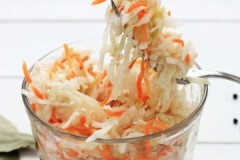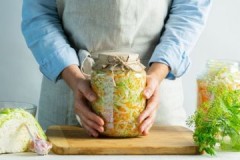Important recommendations on how to store sauerkraut on the balcony in winter
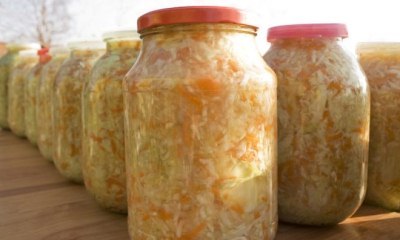 Sauerkraut is one of the favorite dishes of residents of Russia and the post-Soviet space. It is prepared in large quantities in the fall and eaten until the weather warms up.
Sauerkraut is one of the favorite dishes of residents of Russia and the post-Soviet space. It is prepared in large quantities in the fall and eaten until the weather warms up.
In those days when refrigerators were not impressive in size, and not everyone had a cellar, products were stored on the balcony.
This method also comes to the rescue of modern housewives, but you need to resort to it wisely.
Read the article about how to store sauerkraut on the balcony in winter, at what temperature, and whether it is possible in the cold.
Content
Is it possible?
You can store cabbage on the balcony. It is taken outside when large volumes have been prepared and there is not enough space in the refrigerator.
Under such conditions, the cabbage will freeze and thaw several times, which will negatively affect its condition. Blankets and blankets used to cover jars or buckets help improve the situation slightly.
Storage conditions: at what temperature?
 Sending cabbage for storage, it is necessary to take into account weather conditions characteristic of a particular region of the country. For example, in Siberia the thermometer drops to -40 degrees in winter, and in the Krasnodar Territory it rarely drops to -10.
Sending cabbage for storage, it is necessary to take into account weather conditions characteristic of a particular region of the country. For example, in Siberia the thermometer drops to -40 degrees in winter, and in the Krasnodar Territory it rarely drops to -10.
Cabbage will stay fresh if air temperature remains within +4…-2 degrees.At lower elevations it will begin to freeze, and at high elevations fermentation processes will start in it, which will lead to its souring.
The product does not tolerate exposure to the sun. Ultraviolet rays are harmful to it. Therefore, you need to shade the container in every possible way. If glass jars were chosen for storage, then they are:
- wrapped in food foil,
- cover with blankets,
- put away in balcony lockers.
Containers must be covered. The less cabbage comes into contact with oxygen, the better. The jars can be closed with nylon or metal lids, the buckets are covered with plates of suitable size, wrapped in cling film, and the bags are tightly tied.
Any vegetables and fruits can be stored next to sauerkraut, since the container will be closed, so they will not be able to influence each other. The main thing is that the conditions created are suitable for all products.
Preparation
Preparing to store cabbage on the balcony is a mandatory condition on which its shelf life depends.
Steps to take:
- Select healthy heads of cabbage, wash them, cut them and ferment them.
- Wash storage containers. You can use baking soda to remove germs. Before adding cabbage, the container must be scalded with boiling water.
- Drain the brine if storing in bags. In jars, buckets and barrels, cabbage “overwinters” with liquid.
Cabbage on the balcony stored in different containers, namely:
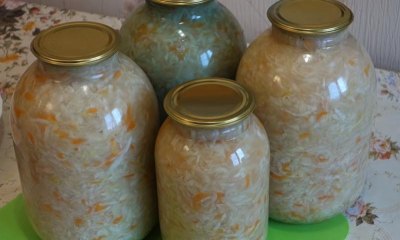 In glass jars. Most often, containers with a volume of 3 liters are used.
In glass jars. Most often, containers with a volume of 3 liters are used.- In enamel or oak barrels. Frozen products are chopped with a hatchet or stabbed with a knife.
- In enamel buckets.
- In plastic bags. You need to expel excess air from them and tie them tightly. Before placing cabbage in bags, be sure to drain the brine from it.
- In vacuum bags or containers. The air is sucked out of them using a special pump.
Product Content Features
You should not store cabbage on the balcony on the floor. It must be located on a raised surface, for example, on a table or in drawers. Depending on whether the room is insulated or not, some features of the product content will differ.
On an insulated loggia
You can store cabbage on an insulated balcony all winter. If the loggia is equipped with adjustable heating, then there will be no problems.
The balcony should be slightly ventilated, as the heat is detrimental to it. In the heat, the product will sour.
On uninsulated
 On an uninsulated balcony, cabbage must be covered. If the winter is warm and the air temperature does not drop below -5...-8 degrees, then You can protect it from freezing as follows:
On an uninsulated balcony, cabbage must be covered. If the winter is warm and the air temperature does not drop below -5...-8 degrees, then You can protect it from freezing as follows:
- insulate the closet using polystyrene foam;
- place jars in it;
- wrap them in several blankets and wrap them with plastic wrap on top;
- close the closet.
This way the cabbage will remain fresh and crispy. If winters are frosty, then you need to be prepared for the fact that it will freeze completely.
In this case, you don’t have to cover it. The blanket is used if the air temperature drops below -20 degrees.
Deadlines
If the cabbage freezes, you can store it on the balcony until it warms up.When the product begins to thaw, it is placed in the freezer.
Helpful information
Storage tips sauerkraut on the balcony:
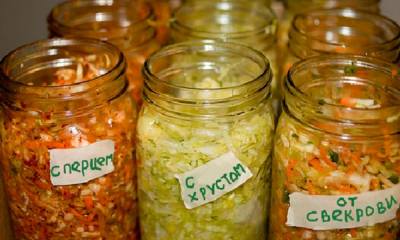 It is not recommended to take it out onto the balcony from mid-November. The jars are put out after a stable low air temperature has established outside, not exceeding +4 degrees.
It is not recommended to take it out onto the balcony from mid-November. The jars are put out after a stable low air temperature has established outside, not exceeding +4 degrees.- To avoid spoilage of large volumes, it is not recommended to take more than 2-3 cans of 3 liters each onto the balcony.
- If sudden and unexpected warming occurs, you can temporarily transfer the product to the refrigerator. The weather situation will have to be monitored at all times.
You will find even more useful information about storing sauerkraut in this section.
Conclusion
You can store sauerkraut on the balcony. If the winters are not harsh, then with the right approach it will remain fresh for several months.
In severe frosts the product will freeze, but after defrosting it returns to its original taste. This cabbage can be eaten fresh or added to various dishes when cooking.
